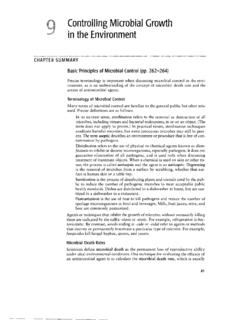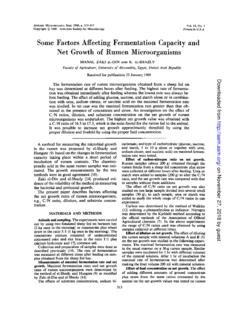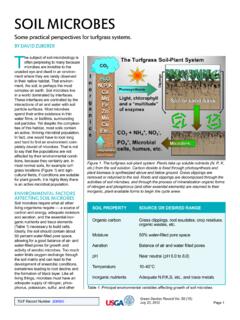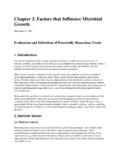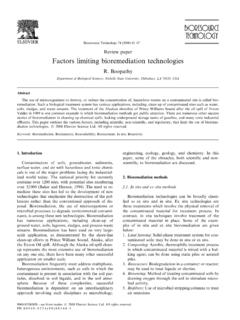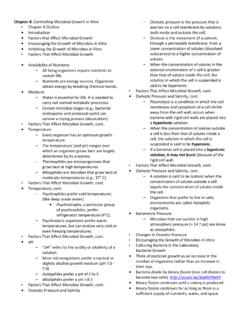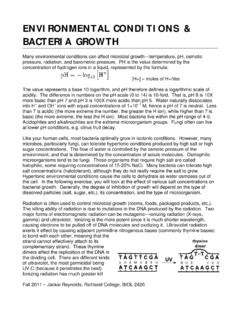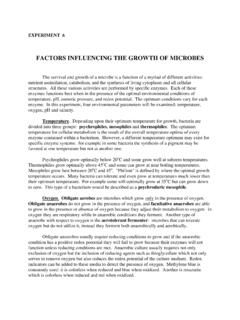Transcription of Microbial Growth - IVCC
1 Microbial Growth Chapter 6. Biology 1009-Summer 2003. Johnson Microbial Growth n Refers to the number of cells, not the size of the cells n Requirements for Growth *Two general types: Physical: temp, pH, osmotic pressure Chemical: elements, including C, N, S, O, and P. Physical Requirements Temperature Psychrophile: cold loving Range 0C-20C. Mesophile: moderate temperature loving Range 20C-40C. Thermophile heat loving Range 40C-100C. 1. Physical Requirements (cont.). n pH. Most bacteria grow between pH Very few grow below pH 4. Some foods (pickles & sauerkraut). preserved from spoilage by acids made by bacterial fermentation Physical Requirements (cont.). n Osmotic Pressure Microbes obtain most of their nutrients in solution from surrounding water Many foods (honey, salted fish) preserved this way: high sugar or salt { } draws water out of bacterial cells, preventing their Growth Chemical Requirements n Carbon-50% of bacteria cell dry wt Microbes obtain from organic materials or CO2.
2 N Iron, copper, and zinc (trace). Used to make enzymes n Nitrogen, sulfur, and phosphorus-14%. of bacterial cell dry wt Needed for synthesis of cellular material 2. Other chemical requirements n Oxygen Bacteria classified based on their oxygen requirements 4 main classifications Obligate Aerobes n Require oxygen to live Obligate Anaerobes n No Growth in the presence of oxygen 3. Facultative n Bacterial Growth with or without oxygen Microaerophilic n Growbest in low concentrations of oxygen (as compared with the normal 21%). Oxygen Requirements 4. Toxic Forms of Oxygen n Singlet oxygen-normal molecular oxygen that has been boosted into high energy state n Superoxide free radicals-formed by all living organisms during respiration n Peroxide anion-found in hydrogen peroxide Superoxide dismutase SOD.
3 N O2 + O2 +2 H+ ----- H2O2. SOD-neutralizes oxygen free radicals *ok, but hydrogen peroxide also toxic . Catalase catalase n2 H2O2 ---------- 2 H2O + O2. Obligate anaerobes lack catalase and superoxide dismutase-they die in the presence of oxygen 5. Culture media n Nutrient material prepared for the Growth of microbes Two main types Chemically defined: Exact chemical composition is known Used to grow very specific organisms Complex: Exact chemical composition unknown Most bacteria and fungi grown on this type Special Culturing Procedures n Anaerobic microbes Require reducing media that removes free oxygen Example-fluid thioglycollate media Require anaerobic containers Example-gas pak jar Require agar stab inoculations Anaerobic Gas Pak 6.
4 More special culturing procedures . n Microaerophilic Bacteria Grow best at reduced oxygen levels and increased carbon dioxide Utilizes a candle jar Normal oxygen- Candle jar oxygen- Normal carbon dioxide- Candle jar carbon dioxide- Candle Jar-used to grow microaerophilic microbes Selective Media n Inhibits the Growth of some bacteria while selecting for the Growth of other organisms Examples: *Brilliant green: isolates Gram . Salmonella *EMB: isolates Gram GI tract microbes 7. Differential Media n Differentiate between different organisms growing on the same plate Example: Blood agar plate (TSA with 10% sheep blood). Used to differentiate types of Streptococci Alpha, beta, and gamma hemolysis Bacterial Division n Increases the number of cells, not size Binary Fission-single cell divides into 2.
5 Identical cells Most bacteria:1 to 3 hr generation time E. coli-generation time of 20 minutes *20 generations (about 7 hours). yields 1 million cells Binary Fission 8. Other bacterial division methods . n Budding-asexual form in which an outgrowth is formed, enlarges, and breaks free n Fragmentation-portion of cell breaks off and generates a new cell Filamentous species only (Actinomycetes). Limiting Environmental factors that Affect Bacterial Growth n Lack of food and water n Space n Accumulation of waste products n Lack of oxygen n Changes in pH. n Temperature fluxuations Phases of Growth n Graph indicating the Growth of a bacterial population over time n Four phases Lag Log Stationary Death 9. Lag Phase n Bacteria first introduced into environment or media n Bacteria get used to their surroundings n Bacteria very active metabolically n Little to no change in cell #.
6 N Lasts 1 hr to several days Log Phase n Rapid (exponential) cell Growth n Bacterialpopulation doubles every generation n Bacteria sensitive to adverse conditions Stationary Phase n Death Rate=rate of reproduction n Cells begin to encounter environmental stress Lack of water Lack of nutrients pH change High amounts of metabolic waste Lack of space Note: Endospores form at this time! 10. Death Phase n Number of deaths exceeds the number of new cells formed n Due to the limiting factors in the environment Bacterial Growth Curve Direct Measurement of Microbial Growth 1) Plate counts-most used method/require serial dilutions *example-pour plates (30-300 colonies countable). 2) Filtration-passage of liquid through a grid containing small pores (<.
7 45 um). 3) Most Probable Number-statistical method used with bacteria that won't grow on media 4) Direct Microscopic Count-known volume of bacterial suspension placed on special cell counting slide 11. Direct Microscopic Count Indirect Methods of Estimating Bacterial Numbers 1) Turbidity-cloudiness produced as media becomes filled with bacteria 2) Metabolic Activity-assumes certain amounts of metabolic wastes are in direct proportion to # of bacteria 3) Dry Weight-organisms removed from media, filtered, and weighed 12.
